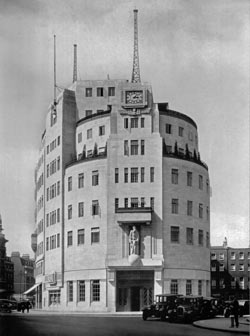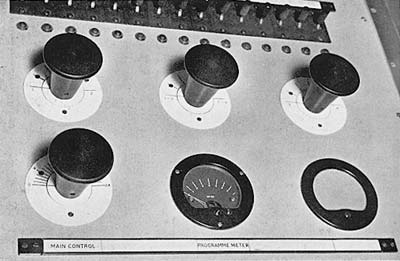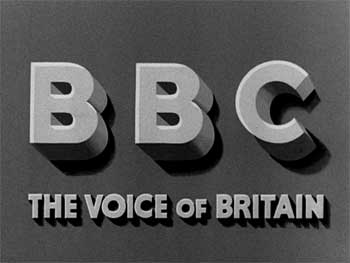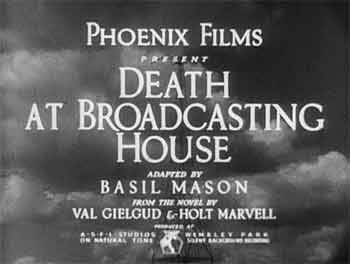Introduction

In addition to this volume, a further book ('A Technical Description of Broadcasting House') detailed various technical aspects of the new building. From this we can attempt to work out just how the broadcasting system worked from microphones to the lines to the transmitters.
These books can still be found in second-hand bookshops and are well worth seeking out, though the technical one can be hard to find. So these pages are an attempt to make their content more easily accessible.
Here you can find most of the photos from the books together with some extra photos from the 1930s. The first volume worked through the building floor by floor and a similar arrangement has been used here. The amount of technical information on these pages has been kept to a minimum.

There is also a selection of articles from the BBC Year Books from 1931 to 1934 including one by the architect Val Myer.
Most of what appears on these pages had gone by the end of the twentieth century. The building underwent a major reconstruction in the early years of the twenty-first, being officially re-opened by the Queen in April 2006.
Roger Beckwith.
If you can supply more information about the early years of BH or wish to comment on this site, you can email me by clicking here.
Sources of information used
Books
- "Broadcasting House" (BBC, 1932)
- "A Technical Description of Broadcasting House" (BBC, 1932)
- BBC Handbooks (BBC, 1932-4)
- "The Modern Boy's Book of Engineering" (Amalgamated Press, c.1936)
- Briggs, Asa: "The Golden Age of Wireless" (OUP, 1965)
- Brooker, F. C.: "Engineering Division Training Manual" (BBC, 1942)
- Campbell, Commander A. B. : "You Have Been Listening To..." (Chapman & Hall Ltd, 1940)
- Chapman, E.H.: "Wireless To-Day" (c.1937)
- Goatman, Wilfrid: "By-Ways of the BBC" (1938)
- Hibberd, Stuart: "This - Is London..." (MacDonald and Evans, 1950)
- Hines, Mark: "The Story of Broadcasting House, Home of the BBC" (Merrell, 2008)
- Lyons, R. S.: "Wonders of Modern Industry" (Blackie & Son Ltd, 1939)
- Pawley, Edward: "BBC Engineering 1922-1972" (BBC, 1972)
- Reid, Colin: "Action Stations - A History of Broadcasting House" (Robson Books, 1987)
- Young, Filson: "The Organ at Broadcasting House" (The John Compton Organ Co.)
- "Architectural Review" (RIBA, 1932)
- "Ariel" (BBC, 1936-1939)
- "Radio Times" (BBC, 13/5/32 and 23/12/32)
- "Wireless World"
- "World Radio" 8/4/32 - 1/7/32
Broadcasting House on Film in the 1930s

This is a documentary made by the General Post Office Film Unit in 1935. It was the most ambitious film made by the unit up to that time and probably the first to use synchronised sound. It was scripted, directed and edited by Stuart Legg. There are, perhaps, too many sequences showing listeners rather than the programme makers but the film does include sequences shot in several studios in Broadcasting House including the drama and sound effects studios, the Vaudeville Studio, BA (complete with dancing girls), the news studios on the fourth floor and the religious studio, 3E. Also included are some regional centres and transmitters. At the time of writing the film is available on DVD in a two-disc set of GPO Film Unit documentaries entitled Addressing the Nation and published by the British Film Institute.

Released in 1934, the film was based on a novel by Val Gielgud and Holt Marvel. Gielgud was Director of Productions at the time, and played the producer in the film. Holt Marvell was the pseudonym of Eric Maschwitz who was Head of Variety. The story concerns the murder of an actor during the performance of a play but there are diversions featuring performances in the Variety studio by Elisabeth Welch and Eve Becke - and the inevitable dancers as seen in the GPO documentary above.
It was issued on DVD in August 2013, the artwork claiming that the broadcasting scenes were shot in Broadcasting House. Although the sets do create a good impression of the building's interior - certainly better than some more recent efforts - there are many details which reveal this was not the case. The Dramatic Control Panel is a very close copy of the real thing and the film does give a hint of how radio plays were created.

